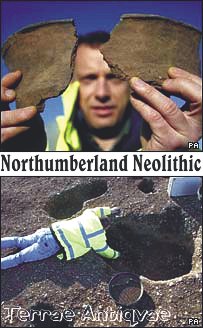Inglaterra. Hallan yacimiento que podría aclarar formas de vida en período Neolítico
 Foto: (1) Archaeologists say it will improve understanding of the Neolithic period.
Foto: (1) Archaeologists say it will improve understanding of the Neolithic period.(2) The discovery was made during routine investigations
Video: See archaeologists working on the site
http://news.bbc.co.uk/1/hi/england/tyne/4399194.stm#
El conocimiento de esas edificaciones puede arrojar información sobre la forma de vida de los hombres en ese periodo prehistórico, ante el debate abierto sobre sí los pobladores neolíticos eran nómadas, como sus antepasados, o tenían una vida sedentaria.
Un yacimiento neolítico descubierto en el norte de Inglaterra puede arrojar luz acerca de la forma de vida del hombre en ese periodo prehistórico, anunciaron hoy los arqueólogos responsables del hallazgo al presentarlo en sociedad.
Los restos, algunos de ellos anteriores a Stonehenge, el monumento prehistórico más famoso del Reino Unido, datado entre 2.200 y 1.600 A.C., fueron hallados en una cantera de Northumberland.
El yacimiento, que se extienden por un área del tamaño de dos campos de fútbol, fue localizado en junio pasado durante una investigación rutinaria.
Entre los restos hallados, los arqueólogos han descubierto tres construcciones datadas en el año 4.000 antes de Cristo, en un periodo temprano del Neolítico, así como otras tres del 3.000 antes de Cristo, correspondientes a una etapa posterior de ese periodo prehistórico.
Los arqueólogos destacaron la importancia de que se hayan conservado construcciones, algo que suele ser raro en los asentamientos neolíticos descubiertos hasta ahora en Inglaterra.
El conocimiento de esas edificaciones puede arrojar información sobre la forma de vida de los hombres en ese periodo prehistórico, ante el debate abierto sobre sí los pobladores neolíticos eran nómadas, como sus antepasados, o tenían una vida sedentaria.
En el interior de una de las edificaciones más tempranas descubiertas, se ha hallado un enterramiento humano colocado en un foso, en el que los arqueólogos encontraron cerámica rota y madera carbonizada.
Además, en el yacimiento se hallaron piezas de cerámica, como cuencos y tarros, herramientas de sílex, una piedra para moler cereales y una bola de piedra tallada, que los arqueólogos piensan que pueda tratarse de un objeto ritual.
"Este es uno de los yacimientos de este tipo más importantes encontrados hasta ahora", explicó el director de las excavaciones, Clive Waddington, para quien el hallazgo "es una oportunidad para comprender mejor a los primeros pobladores del Reino Unido, su forma de vida y sus creencias sobre el mundo".
Fuente: EFE / El Mostrador, 2 de noviembre de 2005
Enlace: http://www.elmostrador.cl/modulos/noticias/constructor/noticia_new.asp?id_noticia=172707
----------------------------------------------------
5,000-year-old homes shed new light on 'henge people'
By David Keys, Archaeology Correspondent
Published: 03 November 2005
A 5,000-year-old settlement that sheds new light on one of Britain's most mysterious prehistoric religious complexes has been unearthed by archaeologists.
Excavations in Northumberland have revealed the existence of a previously unknown settlement, which was probably associated with a nearby series of nine prehistoric ritual centres. Although archaeologists have found scores of circular ritual monuments - or henges - all over Britain, they have never discovered the houses where the henge people lived.
So far the investigations have revealed three houses from the period of the local henge complex - the largest such complex in Britain. Each building was rectangular and made of timber and possibly thatch. The largest was 13 metres long and 5 metres wide.
Dr Jonathan Last,head of research policy for prehistory at English Heritage, said: "To find the remains of so many buildings from the Neolithic period grouped together is incredibly important. This exciting discovery offers huge potential to improve our understanding of Neolithic ways of life in the north-east of England."
The houses are 900m from the series of henge monuments - the largest of which was 100m in diameter and surrounded by banks, ditches and scores of wooden obelisks. Nearby, the archaeologists have also found a much earlier settlement dating from around 1,000 years before the henges were constructed. This earlier settlement appears to have consisted of two roundhouses and a grain storage building - and this reveals bizarre evidence of prehistoric ritual practice. Inside one of the houses, archaeologists have found the remains of a human skeleton buried in a pit. It is possible that the individual - a child or teenager - was a close relative who the inhabitants of the house wanted to keep within the family, even after death.
This earlier settlement - dating from 6,000 years ago - has also yielded three storage pits, probably used originally to store grain but ultimately used to contain some sort of refuse, possibly of a ritualised nature. In one pit archaeologists have found a rough-out for a carved stone ball, of a type thought to have been used in ceremonial rituals.
Neolithic houses in England are relatively rare. There are many known in Ireland. Some have been discovered in Scotland, but in England only about 30 had previously been found.
© 2005 Independent News & Media (UK) Ltd.
Enlace: http://news.independent.co.uk/uk/this_britain/article324300.ece
1 comentario
Vitor Oliveira Jorge -
Saludos
V itor Oliveira Jorge
http://configuracoes.planetaclix.pt